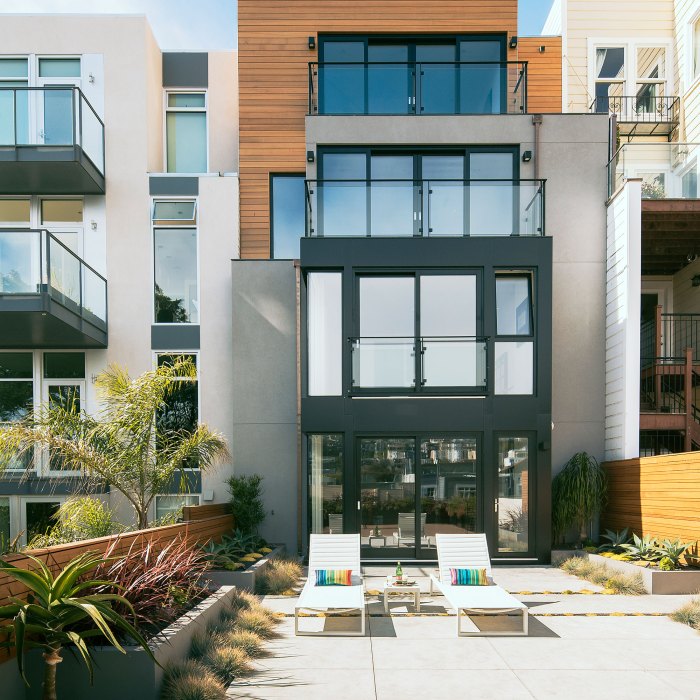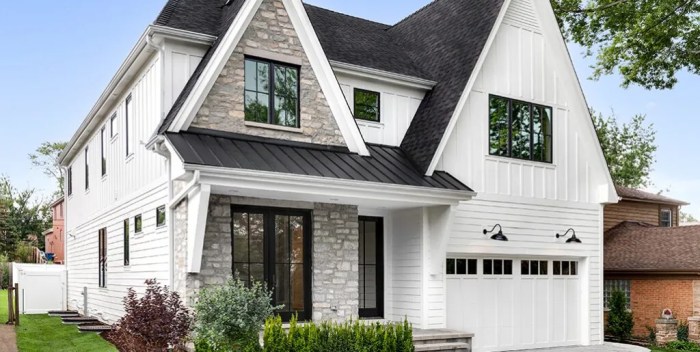Exploring the world of energy efficient home exteriors, this guide dives into the importance of sustainability and the cost-saving benefits that come with it. From design elements to sustainable materials, discover how to create an eco-friendly and efficient home exterior that not only looks great but also helps the environment.
Importance of Energy Efficient Home Exteriors
Energy efficiency in home exteriors plays a crucial role in reducing energy consumption, lowering utility bills, and minimizing the environmental impact of a household. By incorporating energy-efficient materials and design elements, homeowners can create a more sustainable living space while enhancing comfort and increasing property value.
Key Benefits of Energy-Efficient Exteriors
- Improved Insulation: High-quality insulation materials help regulate indoor temperatures, reducing the need for heating and cooling systems.
- Reduced Energy Bills: Energy-efficient exteriors can lead to significant cost savings on monthly utility bills by minimizing energy waste.
- Enhanced Comfort: Proper insulation and air sealing create a more comfortable indoor environment with consistent temperatures throughout the home.
- Environmental Impact: Energy-efficient homes contribute to lower carbon emissions and help preserve natural resources by decreasing energy consumption.
Materials and Design Elements for Energy Efficiency
- Energy-Efficient Windows: Double or triple-pane windows with low-emissivity coatings prevent heat transfer, improving insulation and reducing energy loss.
- Insulated Siding: Insulated siding materials such as vinyl or fiber cement enhance thermal performance and protect against air infiltration.
- Cool Roofing: Reflective roofing materials help deflect sunlight and reduce heat absorption, keeping the home cooler and lowering cooling costs.
- Air Sealing: Properly sealed doors, windows, and gaps in the building envelope prevent air leaks and maintain energy efficiency.
Design Elements for Energy Efficiency
Landscaping plays a crucial role in impacting the energy efficiency of a home exterior. The strategic placement of trees, shrubs, and other vegetation can provide shade during hot summer months, reducing the need for air conditioning. Additionally, planting windbreaks can help protect your home from cold winter winds, decreasing heating costs.
Role of Insulation
Insulation is a key factor in creating an energy-efficient home exterior. Properly insulated walls, roofs, and floors can help maintain a consistent temperature inside the house, reducing the workload on heating and cooling systems. This not only saves energy but also improves comfort levels for occupants.
- High-quality insulation materials such as spray foam, fiberglass, or cellulose can significantly reduce heat transfer through walls and ceilings.
- Proper installation of insulation is crucial to prevent air leakage and ensure maximum efficiency.
- Consider upgrading insulation in older homes to meet current energy efficiency standards and reduce energy bills.
Window Designs for Energy Efficiency
Windows are another important design element that can impact the energy efficiency of a home exterior. Energy-efficient window designs can help reduce heat loss in winter and heat gain in summer, leading to lower energy consumption.
- Double or triple-pane windows with low-emissivity coatings can improve insulation and reduce heat transfer.
- Gas-filled windows, such as those filled with argon or krypton, provide better thermal insulation compared to air-filled windows.
- Window frames made from materials like fiberglass, vinyl, or wood with thermal breaks can enhance energy efficiency.
Sustainable Materials for Energy-Efficient Exteriors

When it comes to creating energy-efficient exteriors for homes, using sustainable materials is key. These materials not only help reduce the environmental impact of construction but also contribute to the overall energy efficiency of the home.Using recycled materials is a great way to promote sustainability and energy efficiency in home exteriors
Recycled materials such as reclaimed wood, recycled metal, and recycled glass can be used for siding, roofing, and insulation. By repurposing these materials, we reduce the need for new production, which in turn saves energy and reduces waste.
Comparison of Energy Efficiency in Roofing Materials
Roofing materials play a crucial role in the energy efficiency of a home. Different materials have varying levels of insulation and heat reflection, which directly impact the energy consumption for heating and cooling. Here is a comparison of the energy efficiency of some common roofing materials:
- Asphalt Shingles: Asphalt shingles are affordable but have low insulation value, leading to higher energy consumption for heating and cooling.
- Metal Roofing: Metal roofs are durable and have high reflectivity, reducing heat absorption and lowering energy costs.
- Clay Tiles: Clay tiles have good insulation properties, keeping the home cool in summer and warm in winter, thus reducing energy usage.
- Slate: Slate roofing is highly durable and offers excellent insulation, making it a sustainable choice for energy-efficient homes.
- Solar Panels: Solar panels not only generate renewable energy but also provide an extra layer of insulation, improving the energy efficiency of the home.
Technologies for Energy-Efficient Home Exteriors

Smart home technologies play a crucial role in enhancing energy efficiency by automating various systems to optimize energy usage. Solar panels are another key technology that can significantly contribute to creating an energy-efficient home exterior. Additionally, passive design strategies offer a sustainable approach to improving energy efficiency without relying on active systems.
Smart Home Technologies for Energy Efficiency
Smart home technologies such as programmable thermostats, smart lighting systems, and energy monitoring devices help homeowners better manage their energy consumption. By allowing users to control and schedule heating, cooling, and lighting systems remotely, these technologies ensure optimal energy usage and reduce waste.
Solar Panels for Energy-Efficient Exteriors
Solar panels harness sunlight to generate electricity, providing a renewable and clean energy source for homes. By installing solar panels on the roof or exterior walls, homeowners can reduce their reliance on traditional energy sources and lower their utility bills.
Additionally, excess energy generated by solar panels can be stored or sold back to the grid, further enhancing energy efficiency.
Passive Design Strategies for Energy Efficiency
Passive design strategies focus on maximizing natural resources such as sunlight, shade, and ventilation to regulate indoor temperatures and lighting. Features like strategic window placement, insulated walls, and natural ventilation systems help reduce the need for artificial heating and cooling, resulting in lower energy consumption and increased comfort for residents.
Final Conclusion
In conclusion, energy efficient home exteriors offer a win-win solution by reducing energy consumption and costs while promoting eco-friendly practices. By incorporating sustainable materials, thoughtful design elements, and innovative technologies, homeowners can create a greener future one exterior at a time.
Expert Answers
What are the key benefits of energy efficient home exteriors?
Energy efficient home exteriors help reduce energy consumption, lower utility bills, and decrease environmental impact by using sustainable materials and innovative technologies.
How does landscaping impact the energy efficiency of a home exterior?
Strategic landscaping can provide natural shade, reduce heat absorption, and improve insulation, leading to overall energy savings for the home.
What are some examples of sustainable materials suitable for energy-efficient exteriors?
Materials like recycled wood, bamboo, and reclaimed metal are great choices for eco-friendly exteriors that promote energy efficiency.
How can smart home technologies enhance energy efficiency?
Smart home devices like thermostats, lighting controls, and energy monitoring systems can optimize energy usage and reduce waste in a home exterior.
What is passive design and how does it improve energy efficiency?
Passive design uses natural elements like sunlight, ventilation, and insulation to regulate temperature and lighting, reducing the need for artificial heating or cooling systems.